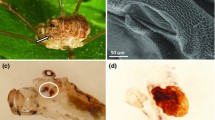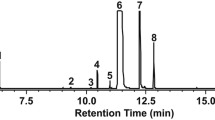Abstract
The cephalic extracts of two species in the stingless bee genusOxytrigona were analyzed. Extracts made in diethyl ether, and then derivatized with diphenyldiazomethane, revealed large quantities of formic acid, potentially a major defensive secretion of this stingless bee group. We additionally identify several hydrocarbons, aldehydes, ketones, and acetates. Novel diketones identified by others were detected in both species.
Similar content being viewed by others
References
Bian, Z., Fales, H.M., Blum, M.S., Jones, T.H., Rinderer, T.E., andHoward, D.F. 1984. Chemistry of cephalic secretion of firebeeTrigona (Oxytrigona) tataira.J. Chem. Ecol. 10:451–461.
Blum, M.S. 1981. Chemical Defenses of Arthropods. Academic Press, New York.
Camargo, J.M.F. 1984. Notas sobre o gêneroOxytrigona (Meliponinae, Apidae, Hymenoptera).Bol. Mus. Paraense E. Goeldi, Zool. 1:115–124.
Cederberg, B. 1977. Chemical basis for defense in bumblebees, p. 77,in Proceedings, Eighth International Congress, International Union for the Study of Social Insects, Wageningen, Netherlands.
CruzLandim, C., andRodrigues, S. 1967. Comparative anatomy and histology of the alimentary canal of adult Apinae.J. Apic. Res. 6:17–28.
Duffield, R.M., Wheeler, J.W., andEickwort, G.C. 1983. Sociochemicals of bees, pp. 387–428,in W.J. Bell and R.T. Cardé (eds.). Chemical Ecology of Insects. Sinauer, Sunderland, Massachusetts.
Eisner, T. 1970. Chemical defenses against predation in arthropods, pp. 157–217,in E. Sondheimer and J.B. Simeone (eds.). Chemical Ecology. Academic Press, New York.
Eisner, T., Meinwald, Y.C., Alsop, D.W., andCarrel, J.E. 1968. Defensive mechanisms of arthropods. XXI. Formic acid andn-nonyl acetate in the defensive spray of two species ofHelluomorpodes.Ann. Entomol. Soc. Am. 61:610–613.
Hefetz, A., andBlum, M.S. 1978. Biosynthesis of formic acid by the poison gland of formicine ants.Biochim. Biophys. Acta 543:484–496.
Hermann, H.R., andBlum, M.S. 1981. Defensive mechanisms in the social Hymenoptera, pp. 78–198.In H.R. Hermann (ed.). Social Insects, Vol. II. Academic Press, New York.
Johnson, L.K., Haynes, L.W., Carlson, M.A., Fortnum, H.A., andGorgas, D.L. 1985. Alarm substances of the stingless bee,Trigona silvestriana.J. Chem. Ecol. 11:409–416.
Kerr, W.E., andda Costa Cruz, C. 1961. Funçaes diferentes tomadas pela glandula mandibular no evoluçao das abelhas em geral e emTrigona (Oxytrigona) tataira em especial.Rev. Bras. Biol. 21:1–16.
Nogueira-Net, P. 1970. Behavior problems related to the pillages made by some parasitic bees (Meliponinae, Apidae), pp. 416–434,in Developement and Evolution of Behavior, Essays in Memory of T.C. Schneiria, W.H. Freeman, San Francisco.
Michener, C.D. 1974. The Social Behavior of the Bees. Harvard University Press, Cambridge, Massachusetts.
Plowright, R.C., andLaverty, T.M. 1984. The ecology and sociobiology of bumblebees.Annu. Rev. Entomol. 29:175–199.
Rembold, H. 1962. Über die biologische Bedeutung der Duftdrusen bei den Landwanzen (Geocorisae).Z. Vergl. Physiol. 45:636–694.
Roubik, D.W. 1980. New species ofTrigona and cleptobioticLestrimelitta from French Guiana (Hymenoptera, Apidae).Rev. Biol. Trop. 26:263–269.
Roubik, D.W. 1983. Nest and colony characteristics of stingless bees from Panama.J. Kans. Entomol. Soc. 56:327–355.
Sakagami, S.F. 1982. Stingless bees, pp. 361–423,in H.R. Hermann (ed.). Social Insects, Vol. III. Academic Press, New York.
Schmidt, J.O. 1982. Biochemistry of insect venoms.Anna. Rev. Entomol. 27:339–368.
Schwarz, H.F. 1948. Stingless bees (Meliponidae) of the western hemisphere.Bull. Am. Mus. Nat. Hist. 90:1–546.
Smith, B.H., andRoubik, D.W. 1983. Mandibular glands of Stingless bees (Hymenoptera: Apidae): Chemical analysis of the contents and their biological function in two species ofMelipona.J. Chem. Ecol. 9(11):1465–1472.
Smith, L.I., andHoward, K.L. 1955. Diphenyldiazomethane, p. 351,in E.C. Horning (ed.). Organic Syntheses, VIII. John Wiley & Sons, New York.
Author information
Authors and Affiliations
Rights and permissions
About this article
Cite this article
Roubik, D.W., Smith, B.H. & Carlson, R.G. Formic acid in caustic cephalic secretions of stingless bee,Oxytrigona (Hymenoptera: Apidae). J Chem Ecol 13, 1079–1086 (1987). https://doi.org/10.1007/BF01020539
Received:
Accepted:
Issue Date:
DOI: https://doi.org/10.1007/BF01020539




